Prince Siddhartha’s journey to Buddhahood...
The Vesak Full Moon Poya Day is tomorrow. It’s the Thrice Blessed Day, the day the Buddha was born, attained Enlightenment and passed away. When we commemorate this day, it would be great to reflect on the lifestory of the Buddha. We know you are being taught this at Dhamma School, but we hope the important incidents of His life we feature here would further enlighten you.
...

The Buddha, Shakyamuni was born as Siddhartha Gautama, the son of a local king in Kapilavastu, (what is now the Indian-Nepalese border) around the fifth century BCE. He was a member of a privileged and wealthy family and enjoyed a comfortable lifestyle.
The story goes back many eras to when there lived an ascetic called Sumedha (the future Buddha) who encountered the Buddha Dipankara. This meeting affected Sumedha in such a way that he too aspired to become a Buddha.
Sumedha worked hard to set out on the path of the cultivation of the “Ten Perfections.” The Bodhisattva cultivated these perfections over many lifetimes. The life, in which he becomes the Buddha Shakyamuni some time in the fifth century BC, represents the completion of Sumedha’s past aspiration and tireless activities.
An old tradition tells us that shortly before his final rebirth, the Bodhisattva spent his life as a god in Thusita (the Heaven of the Contented). Surveying the world from Thusita, the Bodhisattva saw that the time had come for him to take a human birth and at last become a Buddha. The Bodhisattva looked upon for five necessities to be born; time, country, place, race and mother.
The Birth
 Prince Siddhartha walking on lotuses soon after his birth. His birth under the sal tree.
Prince Siddhartha walking on lotuses soon after his birth. His birth under the sal tree.He saw that the ‘Middle Country’ of the great continent of Jambudvipa (India) was the ideal place in which to be born, for its people would be receptive to His message. The Bodhisattva was conceived on the full moon night in July; that night his mother, Maya, dreamt of a white elephant carrying a white lotus in its trunk entering her womb through her right side.
The white elephant here symbolised perfect wisdom and royal power; in India, an elephant was considered the most sacred animal on Earth.When Queen Maya described this dream to the advisors, they said the Queen is going to give birth to a very precious and powerful baby.
Having carried the Bodhisattva in her womb for exactly ten lunar months, Queen Mahamaya gave birth.
On the full moon day in May, passing by the Lumbini grove on her way to her home town, she was captivated by the beauty of the flowering sal trees and stepped down from her palanquin to walk among the trees in the grove. As she reached for a branch of a sal tree, which bent itself down to meet her hand, the cramps of birth came upon her.
As soon as the Bodhisattva was born, he took seven steps to the north and announced: “I am chief in the world, I am best in the world, I am first in the world. This is my last birth. There will be no further rebirths.” Because no child can immediately walk or talk, let alone make declarations at birth, these acts were taken to reveal the Buddha’s extraordinary nature, even as an infant.
The Bodhisattva was born among the Shakya people into a khsatriya family whose name was Gautama. Seven days after his birth his mother died and was born in the Thusita heaven. The child was named Siddhartha, which means “he whose purpose is accomplished.”
Soon after his birth, the infant Bodhisattva was examined by Brahmin specialists for “the thirty-two marks of the great man.” According to Buddhist tradition, two destinies are open to one who possesses these marks in full: he will either become a great “wheel-turning” king, ruling the four quarters of the Earth in perfect justice, or he will become a Buddha.
On hearing the Brahmins saying his son possessed the marks, Suddhodhana, father of the Bodhisattva, determined that his son should become a great king. To this end, he arranged matters that Siddhartha should have no occasion to become unhappy and disappointed with his life at home. In this way Suddhodhana hoped that he might prevent Siddhartha from giving up his home-life for the life of a wandering ascetic.
In search of the truth
After the strange and marvellous circumstances of his birth, Siddhartha grew up as the son of a royal family, confined within his palace, leading a life of luxury enjoyed by the very wealthy and privileged. This lifestyle made him more and more delicate and sensitive. The King didn’t give any opportunity for him to think about any unpleasant side to life.
 Enjoying all the luxuries of a lay life.
Enjoying all the luxuries of a lay life.One day, when Siddhartha was riding with his charioteer he encountered for the first time in his life a feeble old man, a severely ill man, and a corpse being carried to the funeral by mourners. This experience was shocking, and when afterwards he saw a wandering ascetic with serene and composed features, Siddhartha resolved that he will leave his home and take up the life of a wandering ascetic himself.
Siddhartha was now nearly thirty and married to Princess Yasodhara. King Suddhodhana had already begun preparations for the crowning of his heir, and in seven days, Siddhartha was to be crowned. Suddhodhana took every precaution to prevent his son’s flight and even gathered together all Shakya people capable of bearing arms to guard the palace exits. It was then that Siddhartha’s son, Rahula was born.
“It is a bondage which has come to me,” said Siddhartha when he heard of his first-born and only child, meaning that it was another tie added to those already holding him back.
However, that night, as he left his palace, he wanted to see his son. He went to the residence of his wife and opened the door. She was asleep on a bed, her hand on her son’s head. Siddhartha, with one foot in the doorway, stopped and watched.
 Prince Siddhartha leaving the palace.
Prince Siddhartha leaving the palace.“If I lift Yasodhara’s hand to take my son in my arms, she will awaken and my departure will be held back. When I become the Buddha, I will come back and see him.” And with these words he went to his horse, accompanied by his charioteer, Channa; Siddhartha was then twenty-nine years old and this was the beginning of a six-year quest for the truth.
Six-year quest
During these six years, he first spent time with and practised the systems of meditation taught by two leading ascetics of the time, Alara Kalama and Uddaka Rama Putta.
Although he mastered their respective theories, he felt that here he had not found any real answer to the problem of human suffering. So next, in the company of five other wandering ascetics, the Bodhisattva practised two extreme ways, which he thought would lead to Enlightenment.
First he tried the way of giving extreme pleasure to his body, when this failed, he restricted his food intake; as a result he became a living skeleton, but neither did this work. Then he realised that the only way to become the Buddha was to try the middle path.
One day, when he was seated quietly beneath the shade of a rose-apple tree, his mind had settled into a state of deep calm and peace. Buddhist tradition calls this state the first meditation or “dhyana”. As he reflected, it dawned on the Bodhisattva that it was by letting the mind settle into this state of peace that he might discover what he was looking for.
 Subjecting his body to extreme hardships
Subjecting his body to extreme hardshipsThis required that he nourish his body and regain his strength. His five companions thought he had turned away from the quest and left him to his own devices.
Later, a young woman named Sujata offered milk-rice to the Bodhisattva. Now nourished, he seated himself beneath a bo tree, henceforth to be known as “the tree of awakening” or Bodhi Tree. It was once more the night of the Vesak full moon and he made a final resolve: “Let only skin, muscle and bone remain, let the flesh and blood dry in my body, but I will not give up this seat without attaining complete awakening.”
The awakening
Mara is a being who, in certain respects, is like Satan in Christianity. His name means “bringer of death” and his most common nickname is “the Bad One”. Mara is not so much a personification of evil as of the power of all kinds of experience to seduce and entangle the unwary mind.
So, as the Bodhisattva sat beneath the tree, firm in his resolve, Mara approached, mounted on his great elephant and accompanied by his dreadful armies. His one purpose was to assault the Bodhisattva and frustrate his efforts of finding the way to immortality.
The king of death tried to encourage his troops on, but even the arrows of his monsters lost their sharp points and were instantly covered with flowers. Enclosed in a zone of complete protection, the Bodhisattva laughed at his attackers because not a single hair on his body was disturbed.
Having overcome Mara’s attempts to distract him, the Bodhisattva then lifted his right hand and touched the ground calling on the very Earth as his witness. It signalled the defeat of Mara and the Buddha’s complete awakening. As the Buddha touched the Earth, Mara tumbled from his elephant and his armies fled in disarray.
 After the Enlightenment
After the EnlightenmentThe Buddha had achieved His purpose. In Buddhist terms, He had had a direct experience of Nirvana.
The first Buddhists
It is said that at that point His mind inclined not to teach: “This Dharma that I have found is profound, hard to see, hard to understand; it is peaceful, sublime, beyond the sphere of mere reasoning, subtle, to be experienced by the wise. But this generation takes delight in attachment, is delighted by attachment, rejoices in attachment and as such, it is hard for them to see this truth, namely, Nirvana”.
Buddha spent His first seven weeks near the bo tree. He thought for a while about whom He should first teach what He has accomplished. He looked for His first two teachers, but realised that both of them are dead already. Then He remembered the five ascetics who helped him.
 His first sermon
His first sermonIn a deer park outside Benares, the Buddha approached the five and gave them instructions in the path to the termination of suffering that He had discovered. In this way, He set in motion the Wheel of Dharma, and soon, there were six awakened ones in the world. For the Buddha, this was the beginning of a life of teaching that lasted years. Those were the first followers of Buddhism.
Compiled by Janani Amarasekara











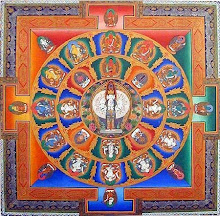




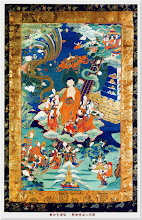

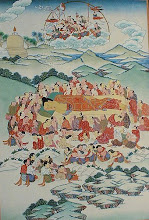


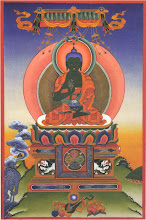




.jpg)

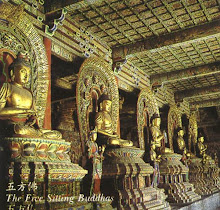













No comments:
Post a Comment